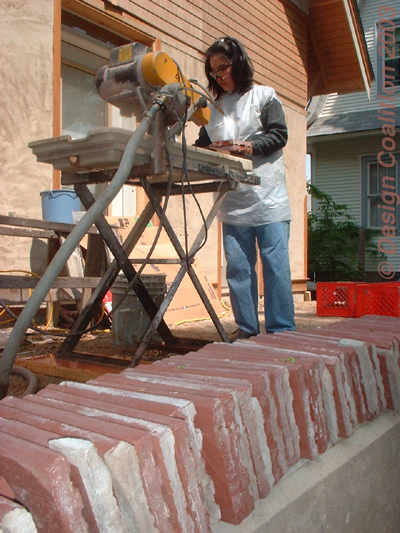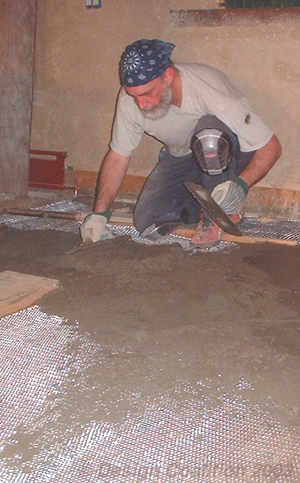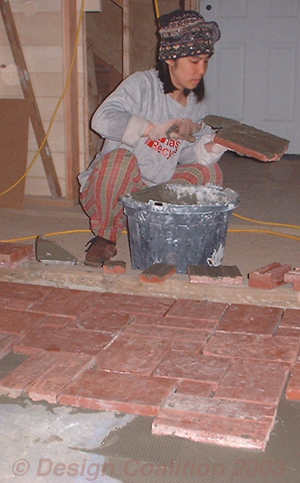A Kitchen Made of Recycled Materials

Still to be installed are the lighting (also from the ReStore) and the range hood-cum-shelf, the center island counter and the EnergyStar refrigerator.
|
Not only the floor tiles are reused. Except for the appliances and sink, nearly every piece of this kitchen is reused or recycled. The countertops are reused laboratory worktops. The cabinets, with commercial quality hardware, were rescued from the now-demolished office building that made way for our city's new performing arts center.
The velvety-blue tiles behind the cooktop were a treasure discovered in Madison's ReStore. Run by Habitat for Humanity, and supported by area businesses and homeowners who donate instead of discard, the ReStore is a resale thrift shop for construction materials.
|

|
Left: The washed floor of reused tiles, grouted with accents of blue tile and an occasional pebble. |
 |
Reusing floor tile is usually not easily done. There is generally too much breakage and surface damage in attempting the salvage operation.
However, our tiles --saved almost 20 years ago from a university building slated for demolition-- are thick and strong. The durable tiles were able to withstand the prying needed to free them from the old floor. We found that we could fairly easily remove most of the old mortar used in the original installation. And, because the tiles are square-edged and non-glazed, we could cut off those portions with surface damage and still use the remaining piece.
Left: Janet cuts off old grout and flaws with the wet saw. |
The water-cooled diamond-studded blade makes satisfingly quick and accurate cuts. Our friend Oma, who salvaged the tiles, has already done a great deal of cleaning and trimming. Still, it takes Janet a whole day of work to finish preparing two hundred-odd tiles.
Each tile has to be inspected and sorted. A few tiles are so damaged that she can only salvage a half or a quarter. Janet has to decide if a flaw can be cut away or if she will need to pair a partially damaged tile with another to make a "whole" tile -- always allowing for the width of the extra grout joints. Sometimes she cuts off a bit of damaged corner, an "accidental" that will appear as a small triangle shape in the grout joint. The remaining surface flaws and varied sizes and shapes will add character to the finished installation.

|

|
| Above: Lou begins the floor construction by laying a mortar bed on top of the earthen subslab, reinforced with metal lath. He uses a magnesium float to level, and a steel trowel to finish. We cover it with plastic and allow it to cure slowly. After a week we're ready to lay the tile. |
Above: Because the old tiles are actually heavy pavers with deep lugs on the bottom side, Janet butters them with thinset morter before laying. With the varied tile sizes, we lay each one carefully, taking considerable pondering to achieve an artistic result. |
Top of Page
Design concepts | Site | Workshop | In-progress | House Details | Research | Interview w/ Lou
|